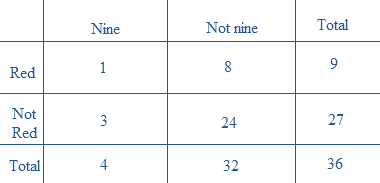
Concept explainers
(a)
Two − way table describing
(a)
Explanation of Solution
Given information:
R: get a red disk
N: get a disk with the number 9
For two − way table,
We are required to make two rows and two columns.
Let us name the rows and columns according to the events R and N.
Rows: red, not red.
Columns: nine, not nine.
Since there are 36 disks in total, we have to mention 36 in the bottom left corner of the table.
We know that
There are 9 disks of red, blue, green and yellow each.
This implies
There are 9 disks which are red in color.
And
Remaining 27 disks of blue, green and yellow color.
We also know that
Each color disks are numbered 1 − 9.
This implies
There is only 1 disk which is colored red and numbered nine.
And
Remaining 3 disks are numbered 9 and of different color.
This also implies
With only 1 disk of number 9 and colored red, remaining 8 disks of red color are numbered 1 − 8.
Since 3 disks of different color are numbered 9, remaining 24 disks of different color are numbered 1 − 8.
Two − way table is shown as:

(b)
Probabilities of both events R and N.
(b)
Answer to Problem 46E
Probabilities:
For
For event N,
Explanation of Solution
Given information:
R: get a red disk
N: get a disk with the number 9
We know that
9 out of 36 disks are red in color.
When number of favorable outcomes are divided by the number of possible outcomes, we get the
We also know that
Each color disks are numbered 1 − 9.
With 4 colors, 4 disks are numbered 9 among 36 disks.
(c)
Discuss the event “R and N” and also find its probability.
(c)
Answer to Problem 46E
Probability for event,
Explanation of Solution
Given information:
R: get a red disk
N: get a disk with the number 9
“R and N” represents the event that the disk is numbered 9 and red in color.
We know that
Out of total 36 disks, there are 9 disks which are red in color.
Since each color disks are numbered 1 − 9.
This implies
There is only one disk which is numbered 9 and red in color among all 36 disks and possesses the event “R and N”.
Now,
For the probability,
Number of favorable outcomes are divided by the number of possible outcomes.
(d)
Discuss the probability of event “R or N” is not equal to the sum of individual probabilities of both events. Furthermore, general
(d)
Answer to Problem 46E
Probability for event,
Explanation of Solution
Given information:
R: get a red disk
N: get a disk with the number 9
For any two events,
General addition rule:
According to the statement,
This is due to the events R and N are not mutually exclusive events.
That means
The occurrence of both the events at the same time is possible.
Such that
From Part (b) and (c),
We have
Probabilities,
For event R:
For event N:
For event “R and N”
Apply general addition rule for any two events:
Chapter 5 Solutions
PRACTICE OF STATISTICS F/AP EXAM
Additional Math Textbook Solutions
Basic Business Statistics, Student Value Edition
Essentials of Statistics (6th Edition)
Statistics: The Art and Science of Learning from Data (4th Edition)
Intro Stats, Books a la Carte Edition (5th Edition)
 MATLAB: An Introduction with ApplicationsStatisticsISBN:9781119256830Author:Amos GilatPublisher:John Wiley & Sons Inc
MATLAB: An Introduction with ApplicationsStatisticsISBN:9781119256830Author:Amos GilatPublisher:John Wiley & Sons Inc Probability and Statistics for Engineering and th...StatisticsISBN:9781305251809Author:Jay L. DevorePublisher:Cengage Learning
Probability and Statistics for Engineering and th...StatisticsISBN:9781305251809Author:Jay L. DevorePublisher:Cengage Learning Statistics for The Behavioral Sciences (MindTap C...StatisticsISBN:9781305504912Author:Frederick J Gravetter, Larry B. WallnauPublisher:Cengage Learning
Statistics for The Behavioral Sciences (MindTap C...StatisticsISBN:9781305504912Author:Frederick J Gravetter, Larry B. WallnauPublisher:Cengage Learning Elementary Statistics: Picturing the World (7th E...StatisticsISBN:9780134683416Author:Ron Larson, Betsy FarberPublisher:PEARSON
Elementary Statistics: Picturing the World (7th E...StatisticsISBN:9780134683416Author:Ron Larson, Betsy FarberPublisher:PEARSON The Basic Practice of StatisticsStatisticsISBN:9781319042578Author:David S. Moore, William I. Notz, Michael A. FlignerPublisher:W. H. Freeman
The Basic Practice of StatisticsStatisticsISBN:9781319042578Author:David S. Moore, William I. Notz, Michael A. FlignerPublisher:W. H. Freeman Introduction to the Practice of StatisticsStatisticsISBN:9781319013387Author:David S. Moore, George P. McCabe, Bruce A. CraigPublisher:W. H. Freeman
Introduction to the Practice of StatisticsStatisticsISBN:9781319013387Author:David S. Moore, George P. McCabe, Bruce A. CraigPublisher:W. H. Freeman





